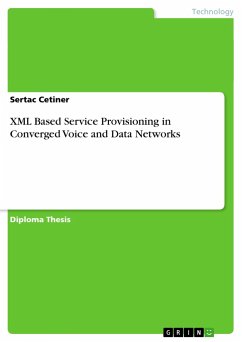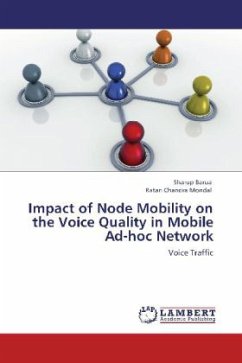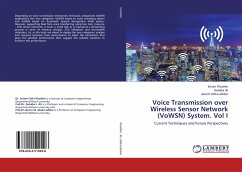Avi Perry
Fundamentals of Voice-Quality Engineering in Wireless Networks
Avi Perry
Fundamentals of Voice-Quality Engineering in Wireless Networks
- Gebundenes Buch
- Merkliste
- Auf die Merkliste
- Bewerten Bewerten
- Teilen
- Produkt teilen
- Produkterinnerung
- Produkterinnerung
This book describes solutions for maximizing voice quality over wireless networks at the device and system levels.
Andere Kunden interessierten sich auch für
![Fundamentals of Voice-Quality Engineering in Wireless Networks Fundamentals of Voice-Quality Engineering in Wireless Networks]() Avi PerryFundamentals of Voice-Quality Engineering in Wireless Networks84,99 €
Avi PerryFundamentals of Voice-Quality Engineering in Wireless Networks84,99 €![Voice over IP in Wireless Heterogeneous Networks Voice over IP in Wireless Heterogeneous Networks]() Hanane FathiVoice over IP in Wireless Heterogeneous Networks75,99 €
Hanane FathiVoice over IP in Wireless Heterogeneous Networks75,99 €![Voice over IP Networks Voice over IP Networks]() Pramode K. VermaVoice over IP Networks75,99 €
Pramode K. VermaVoice over IP Networks75,99 €![Voice over IP Networks Voice over IP Networks]() Pramode K. VermaVoice over IP Networks75,99 €
Pramode K. VermaVoice over IP Networks75,99 €![XML Based Service Provisioning in Converged Voice and Data Networks XML Based Service Provisioning in Converged Voice and Data Networks]() Sertac CetinerXML Based Service Provisioning in Converged Voice and Data Networks47,95 €
Sertac CetinerXML Based Service Provisioning in Converged Voice and Data Networks47,95 €![Impact of Node Mobility on the Voice Quality in Mobile Ad-hoc Network Impact of Node Mobility on the Voice Quality in Mobile Ad-hoc Network]() Sharup BaruaImpact of Node Mobility on the Voice Quality in Mobile Ad-hoc Network32,99 €
Sharup BaruaImpact of Node Mobility on the Voice Quality in Mobile Ad-hoc Network32,99 €![Voice Transmission over Wireless Sensor Network (VoWSN) System. Vol I Voice Transmission over Wireless Sensor Network (VoWSN) System. Vol I]() Ina'am KhudherVoice Transmission over Wireless Sensor Network (VoWSN) System. Vol I50,99 €
Ina'am KhudherVoice Transmission over Wireless Sensor Network (VoWSN) System. Vol I50,99 €-
-
-
This book describes solutions for maximizing voice quality over wireless networks at the device and system levels.
Produktdetails
- Produktdetails
- Verlag: Cambridge University Press
- Seitenzahl: 376
- Erscheinungstermin: 3. Februar 2016
- Englisch
- Abmessung: 250mm x 175mm x 25mm
- Gewicht: 827g
- ISBN-13: 9780521855952
- ISBN-10: 0521855950
- Artikelnr.: 21166941
- Herstellerkennzeichnung
- Libri GmbH
- Europaallee 1
- 36244 Bad Hersfeld
- gpsr@libri.de
- Verlag: Cambridge University Press
- Seitenzahl: 376
- Erscheinungstermin: 3. Februar 2016
- Englisch
- Abmessung: 250mm x 175mm x 25mm
- Gewicht: 827g
- ISBN-13: 9780521855952
- ISBN-10: 0521855950
- Artikelnr.: 21166941
- Herstellerkennzeichnung
- Libri GmbH
- Europaallee 1
- 36244 Bad Hersfeld
- gpsr@libri.de
Dr Avi Perry, a key contributor to the ITU-T G.168 standard, is currently an independent consultant. He was Vice President at NMS Communications, where he was responsible for core technology, system engineering, competitive analysis, documentation, and technical support. He has also held positions at Lucent Technologies and Bell Laboratories and the Northwestern University Graduate School of Management.
Introduction
Part I. Voice Quality Foundations: 1. An overview of voice coding architectures in wireless communications
2. Quantitative assessment of voice quality
Part II. Applications: 3. Electrical echo and echo cancellation
4. Acoustic echo and its control
5. Noisy ambience, mobility, and noise reduction
6. Speech level control
Part III. Wireless Architectures: 7. Mobile-to-mobile stand-alone VQS architectures and their implications on data communications
8. The VQS evolution to 3G
Part IV. A Network Operator Guide for Selecting, Appraising, and Testing VQS: 9. A network operator guide to testing and appraising voice quality systems
10. Service provider's system, management, and delivery, requirements
11. Making economically sound investment decisions concerning voice quality systems
Part V. Managing the Network: 12. Trouble shooting and case studies
Part VI. Afterthoughts and Some Fresh Ideas: 13. Tracer probe
14. My sound
15. A procedure for evaluating and contrasting new wireless codecs performance with and without VQS
16. The theory of sleep
Part VII. Recordings: 17. Audio illustrations
Glossary of common voice quality systems terminology
Abbreviations.
Part I. Voice Quality Foundations: 1. An overview of voice coding architectures in wireless communications
2. Quantitative assessment of voice quality
Part II. Applications: 3. Electrical echo and echo cancellation
4. Acoustic echo and its control
5. Noisy ambience, mobility, and noise reduction
6. Speech level control
Part III. Wireless Architectures: 7. Mobile-to-mobile stand-alone VQS architectures and their implications on data communications
8. The VQS evolution to 3G
Part IV. A Network Operator Guide for Selecting, Appraising, and Testing VQS: 9. A network operator guide to testing and appraising voice quality systems
10. Service provider's system, management, and delivery, requirements
11. Making economically sound investment decisions concerning voice quality systems
Part V. Managing the Network: 12. Trouble shooting and case studies
Part VI. Afterthoughts and Some Fresh Ideas: 13. Tracer probe
14. My sound
15. A procedure for evaluating and contrasting new wireless codecs performance with and without VQS
16. The theory of sleep
Part VII. Recordings: 17. Audio illustrations
Glossary of common voice quality systems terminology
Abbreviations.
Introduction
Part I. Voice Quality Foundations: 1. An overview of voice coding architectures in wireless communications
2. Quantitative assessment of voice quality
Part II. Applications: 3. Electrical echo and echo cancellation
4. Acoustic echo and its control
5. Noisy ambience, mobility, and noise reduction
6. Speech level control
Part III. Wireless Architectures: 7. Mobile-to-mobile stand-alone VQS architectures and their implications on data communications
8. The VQS evolution to 3G
Part IV. A Network Operator Guide for Selecting, Appraising, and Testing VQS: 9. A network operator guide to testing and appraising voice quality systems
10. Service provider's system, management, and delivery, requirements
11. Making economically sound investment decisions concerning voice quality systems
Part V. Managing the Network: 12. Trouble shooting and case studies
Part VI. Afterthoughts and Some Fresh Ideas: 13. Tracer probe
14. My sound
15. A procedure for evaluating and contrasting new wireless codecs performance with and without VQS
16. The theory of sleep
Part VII. Recordings: 17. Audio illustrations
Glossary of common voice quality systems terminology
Abbreviations.
Part I. Voice Quality Foundations: 1. An overview of voice coding architectures in wireless communications
2. Quantitative assessment of voice quality
Part II. Applications: 3. Electrical echo and echo cancellation
4. Acoustic echo and its control
5. Noisy ambience, mobility, and noise reduction
6. Speech level control
Part III. Wireless Architectures: 7. Mobile-to-mobile stand-alone VQS architectures and their implications on data communications
8. The VQS evolution to 3G
Part IV. A Network Operator Guide for Selecting, Appraising, and Testing VQS: 9. A network operator guide to testing and appraising voice quality systems
10. Service provider's system, management, and delivery, requirements
11. Making economically sound investment decisions concerning voice quality systems
Part V. Managing the Network: 12. Trouble shooting and case studies
Part VI. Afterthoughts and Some Fresh Ideas: 13. Tracer probe
14. My sound
15. A procedure for evaluating and contrasting new wireless codecs performance with and without VQS
16. The theory of sleep
Part VII. Recordings: 17. Audio illustrations
Glossary of common voice quality systems terminology
Abbreviations.









